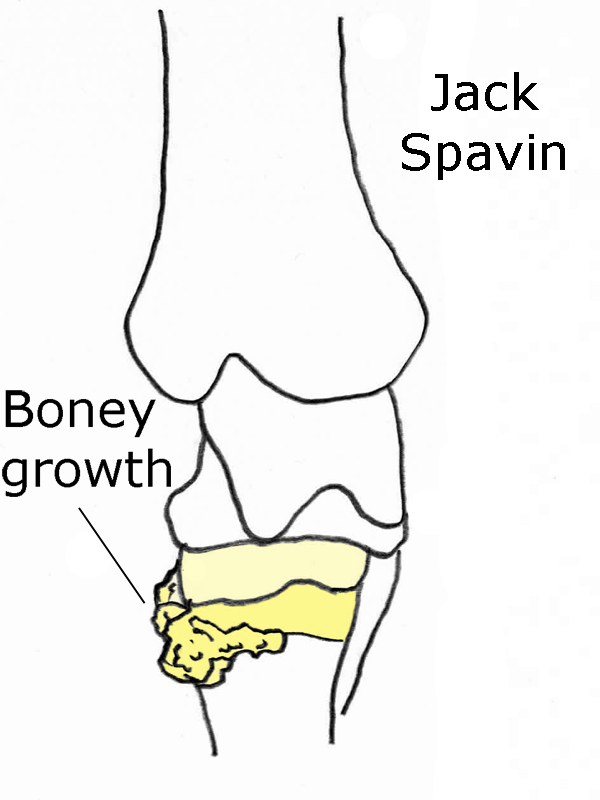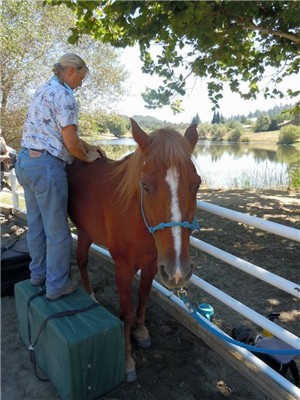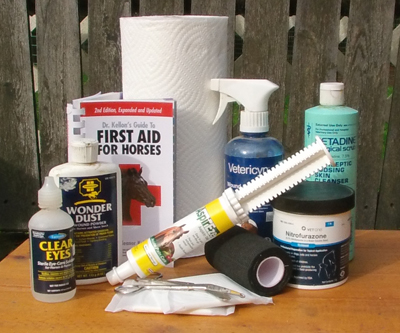Managing Bone Spavin in Horses
Recognize it Before You Make a Purchase
Bone spavin is osteoarthritis of the hock. Osteoarthritis meaning: degenerative joint disease where the cartilage fails and the underlying bone is affected. The arthritis does not effect the entire hock, but rather the lower two joints. It is one of the top sport-horse-related injuries veterinarians and equine owners are confronted with.
The long-term outcome of hock arthritis ranges from complete recovery to chronic lameness.
The bad news is that bone spavin is painful and causes lameness. The good news is that once the affected joints fuse together, if they fuse together, the pain and lameness goes away.
Fusion or ankylosis, is the growth of new bone and fusion of the joint.
You may be wondering how a horse can function with a fused joint in his back leg. In the case of bone spavin they can. This is because the two lower joints account for only 10% of the total hock movement. Nearly all of the hock movement takes place in the upper two joints.
If bone fusion can be achieved, the horse can return to healthy performance in all but the most demanding of sports. The older the horse is, the less the likelihood of ankylosis.

Causes and Types
Arthritis is caused by undue stress on the joints. This can be due to a stressful work load on the joints, poor conformation or bad shoeing. There are several different names to describe the type/cause of spavin. Blind spavin has a higher recovery rate than jack spavin.
High Stress Sports
Reining, Cattle penning, Dressage, Jumping, Barrel racing and Racing.

Juvenile spavin describes bone spavin in foals due to abnormal bone development.
Blind spavin and Occult spavin describe spavin that can not be felt with the fingers and is hidden deep in the joint. This is commonly seen when very young horses are overworked (eg. race horses).
Jack spavin describes the type were a bony growth pushes out and interferes with the overlying tendon.
Bone spavin usually describes the adult version that is caused by long term wear and tear.
Symptoms of Bone Spavin
Did You Know?
It is possible to have an enlarged hock joint with no pain or lameness.
It is also possible to have a joint that appears normal under x-rays that is very painful.
- Cold lameness (lame while not working)
- Intermittent lameness
- Stiffness
- Dragging back toes
- Lower back pain
- Horse shifts weight to the front legs when standing
- May have swelling around the inside lower hock joint(s)
- May have bony growth over inside lower hock joint(s)
- Horse tries to take weight off the inside of hocks
- Back legs appear unsteady or feeble when traveling down steep grades
Sometimes lameness is masked when both hocks are affected because of the uniformity of the walking pattern. It may reveal itself as stiffness and lower back pain.
The lower back pain is caused by the horse compensating for the painful joints. Equine Chiropractics can provide back pain relief to horses suffering from bone spavin.

Diagnosing Bone Spavin
Arthritis is usually diagnosed with a combination of flexion tests and x-rays. In a flexion test the horse's hind foot is held up toward the belly for 30-45 seconds and then released.
Upon release the horse will limp the first few steps when asked to trot out. The vet may inject the joint with a pain blocker to pinpoint the affected area. Lastly, x-rays may be taken to look for cartilage/bone surface degeneration and any boney growth forming around the joint. Joint damage is irreversible.
This video clearly illustrates the restricted movement of a horse with joint damage vs. a healthy horse.
Treatment for Bone Spavin
Treatments for arthritis in the hock joint are designed to provide pain relief and/or encourage bone fusion.
Pain medications are used to reduce pain. Phenylbutazone or 'Bute' is the most common drug of choice. The horse may be ridden either normally or at reduced exercise as recommended by your vet. In time, some may have spontaneous joint fusion. The lameness and need for pain control will go away.
What is Remedial Shoeing?
Horse shoeing designed to treat disease and injury such as laminitis, navicular syndrome, joint disease, split hooves and such.
Remedial shoeing is designed to relieve pain/swelling and balance the weight load on the joint and hoof. If the hoof is worn on one side, wedges may be used to balance the foot. As the foot grows out the wedges will be adjusted accordingly.
Care is taken to support the heel without crushing it. Square or rolled toes are used to assist with break over so the horse is not dragging the toe. The hoof can out grow the need for wedges, but will always need square toes. Even if the bones fuse together.
Joint injections can be used two ways: To relieve pain and swelling or to dissolve cartilage to promote bone fusion.
Corticosteroids injected into the joints can provide weeks, months and sometimes years of pain relief. These injections will not prevent the disease from progressing, but will provide pain relief for a while. The effectiveness can decrease over time as the severity of the disease progresses.
Sodium moniodoacetate (MIA) injected into the joints dissolves the cartilage. It is very painful and the horse is treated for pain accordingly. MIA can cause soft tissue damage as well. The joint gets worse before it gets better until the bones finally fuse. Some horses respond to this treatment better than others.
Surgery to remove the cartilage and fuse the joints is done as a last resort when other treatments are no longer working. One related surgical procedure is to cut the tendon that is disrupted by a jack spavin. This has mixed results. Surgery is very invasive and does come with some risk. The option of surgery would likely be recommended for a younger horse rather than an old one.

Exercise
Pain and treatment can be managed to the extent that some horses are able to continue their current work program. Others require a much lighter work load. The decision on how much to exercise your horse should be made at your vet's recommendation.
All horses with bone spavin will benefit from daily light exercise. Avoid lunging or riding in circles as this puts an uneven stress on the already stressed joint. Straight line flat work is preferred.
Preventing Bone Spavin
- Don't overwork young, growing horses
- Don't use a horse with poor conformation for high joint-stress type sports
- Treat all hock sprain injuries promptly and allow proper healing time
- Keep the feet properly balanced by a skilled farrier
Bone spavin has a history of varied outcomes. Some horses heal completely with a fused joint. Some horses suffer chronic pain and lameness. Some horses are able to function as pleasure horses and other low-demand riding with pain management. Check with your vet to keep abreast of better and more effective methods as they are developed.
More Equine Health Articles:
This information is written for the horseman to better understand and cope with the variety of disease and injury that can occur during the course of horse ownership. Always consult with your Veterinarian regarding the care and treatment of your equine.
Home > Horse Diseases > Bone Spavin



